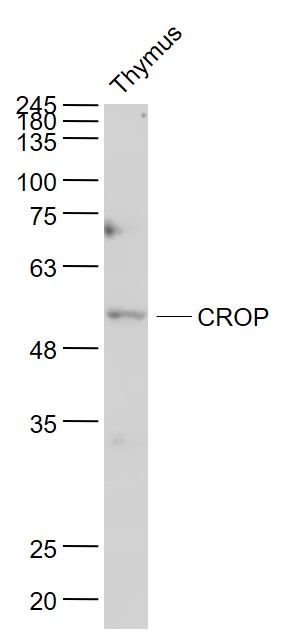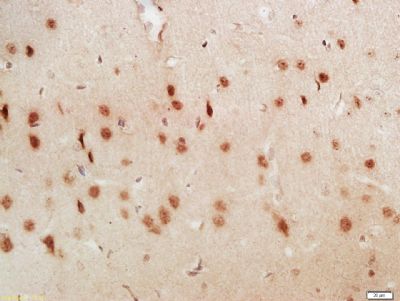CROP Polyclonal Antibody
Purified Rabbit Polyclonal Antibody (Pab)
- SPECIFICATION
- CITATIONS
- PROTOCOLS
- BACKGROUND

Application
| WB, IHC-P, IHC-F, IF, ICC, E |
|---|---|
| Primary Accession | O95232 |
| Reactivity | Rat, Pig, Bovine |
| Host | Rabbit |
| Clonality | Polyclonal |
| Calculated MW | 51 KDa |
| Physical State | Liquid |
| Immunogen | KLH conjugated synthetic peptide derived from human CROP |
| Epitope Specificity | 31-130/432 |
| Isotype | IgG |
| Purity | affinity purified by Protein A |
| Buffer | 0.01M TBS (pH7.4) with 1% BSA, 0.02% Proclin300 and 50% Glycerol. |
| SUBCELLULAR LOCATION | Nucleus speckle. The subnuclear localization is affected by cisplatin. |
| SIMILARITY | Belongs to the Luc7 family. |
| Post-translational modifications | Phosphorylated in vitro by SRPK1, SRPK2 and CLK1. Phosphorylated upon DNA damage, probably by ATM or ATR. |
| Important Note | This product as supplied is intended for research use only, not for use in human, therapeutic or diagnostic applications. |
| Background Descriptions | This gene encodes a protein with an N-terminal half that contains cysteine/histidine motifs and leucine zipper-like repeats, and the C-terminal half is rich in arginine and glutamate residues (RE domain) and arginine and serine residues (RS domain). This protein localizes with a speckled pattern in the nucleus, and could be involved in the formation of splicesome via the RE and RS domains. Two alternatively spliced transcript variants encoding the same protein have been found for this gene. [provided by RefSeq, Aug 2009] |
| Gene ID | 51747 |
|---|---|
| Other Names | Luc7-like protein 3, Cisplatin resistance-associated-overexpressed protein, Luc7A, Okadaic acid-inducible phosphoprotein OA48-18, cAMP regulatory element-associated protein 1, CRE-associated protein 1, CREAP-1, LUC7L3, CREAP1, CROP, O48 |
| Target/Specificity | Widely expressed. Highest levels in heart, brain, pancreas, thymus, ovary, small intestine and peripheral blood leukocytes, as well as cerebellum, putamen and pituitary gland. Lowest levels in lung, liver and kidney. Also expressed in fetal tissues, including brain, heart, kidney, thymus and lung. |
| Dilution | WB=1:500-2000,IHC-P=1:100-500,IHC-F=1:100-500,ICC=1:100-500,IF=1:100-500,ELISA=1:5000-10000 |
| Storage | Store at -20 ℃ for one year. Avoid repeated freeze/thaw cycles. When reconstituted in sterile pH 7.4 0.01M PBS or diluent of antibody the antibody is stable for at least two weeks at 2-4 ℃. |
| Name | LUC7L3 |
|---|---|
| Synonyms | CREAP1, CROP, O48 |
| Function | Binds cAMP regulatory element DNA sequence. May play a role in RNA splicing. |
| Cellular Location | Nucleus speckle. Note=The subnuclear localization is affected by cisplatin |
| Tissue Location | Widely expressed. Highest levels in heart, brain, pancreas, thymus, ovary, small intestine and peripheral blood leukocytes, as well as cerebellum, putamen and pituitary gland. Lowest levels in lung, liver and kidney. Also expressed in fetal tissues, including brain, heart, kidney, thymus and lung |

Thousands of laboratories across the world have published research that depended on the performance of antibodies from Abcepta to advance their research. Check out links to articles that cite our products in major peer-reviewed journals, organized by research category.
info@abcepta.com, and receive a free "I Love Antibodies" mug.
Provided below are standard protocols that you may find useful for product applications.
If you have used an Abcepta product and would like to share how it has performed, please click on the "Submit Review" button and provide the requested information. Our staff will examine and post your review and contact you if needed.
If you have any additional inquiries please email technical services at tech@abcepta.com.













 Foundational characteristics of cancer include proliferation, angiogenesis, migration, evasion of apoptosis, and cellular immortality. Find key markers for these cellular processes and antibodies to detect them.
Foundational characteristics of cancer include proliferation, angiogenesis, migration, evasion of apoptosis, and cellular immortality. Find key markers for these cellular processes and antibodies to detect them. The SUMOplot™ Analysis Program predicts and scores sumoylation sites in your protein. SUMOylation is a post-translational modification involved in various cellular processes, such as nuclear-cytosolic transport, transcriptional regulation, apoptosis, protein stability, response to stress, and progression through the cell cycle.
The SUMOplot™ Analysis Program predicts and scores sumoylation sites in your protein. SUMOylation is a post-translational modification involved in various cellular processes, such as nuclear-cytosolic transport, transcriptional regulation, apoptosis, protein stability, response to stress, and progression through the cell cycle. The Autophagy Receptor Motif Plotter predicts and scores autophagy receptor binding sites in your protein. Identifying proteins connected to this pathway is critical to understanding the role of autophagy in physiological as well as pathological processes such as development, differentiation, neurodegenerative diseases, stress, infection, and cancer.
The Autophagy Receptor Motif Plotter predicts and scores autophagy receptor binding sites in your protein. Identifying proteins connected to this pathway is critical to understanding the role of autophagy in physiological as well as pathological processes such as development, differentiation, neurodegenerative diseases, stress, infection, and cancer.



